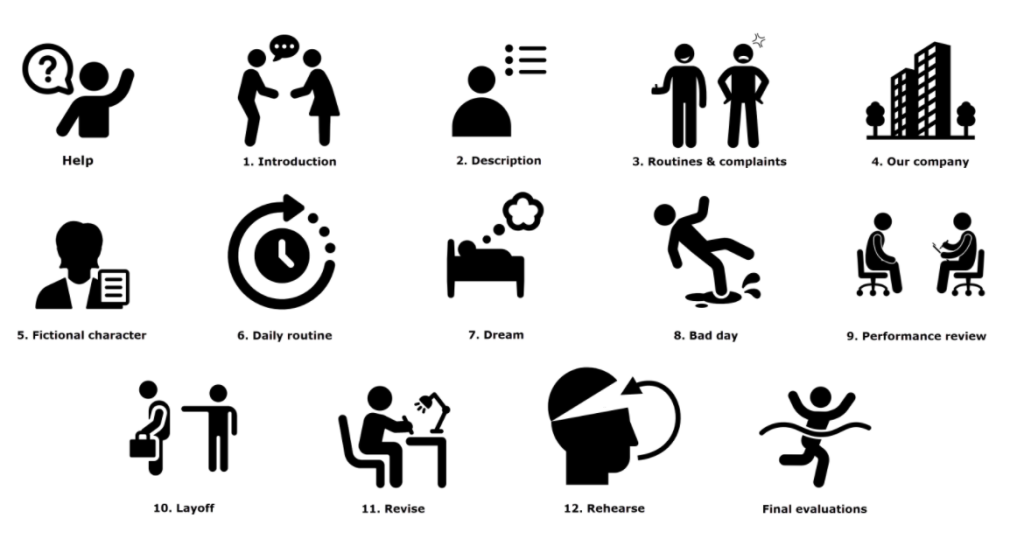
Actively Engaged on the Job
This ESL textbook is very different from other b-block textbooks. It addresses the government objectives by encouraging fluency and creativity. For students at the high-beginner level, the Ministry competency statement specifically calls for new ideas, good grammar, field-related vocabulary, and revision strategies. This textbook delivers those elements with enthusiasm and laughter.
- Communication (orale) claire et cohérente accessible à un non-expert. Communication appropriée à la situation. Utilisation convenable de termes liés au champ d’études. Application convenable du code grammatical. Manifestation d’ouverture et de respect
- Rédaction claire et cohérente d’un texte, d’environ 350 mots, lié à son champ d’études, accessible à un non-expert. Respect de la situation et de l’objectif de communication. Présence d’idées et d’expressions nouvelles. Application convenable du code grammatical, syntaxique et orthographique. Emploi convenable de termes de base liés à son champ d’études. Utilisation convenable de procédés de communication liés à la tâche d’écriture. Utilisation appropriée de stratégies de révision.
Actively Engaged on the Job is different from what teachers are used to—but exactly what students need. Instead of essay writing, low intermediates using this book to master first-person narratives. Students work together in groups, collaborating to develop dramatic first-person stories. Each week, the just-in-time grammar and vocabulary lessons are exactly what they need for the next chapter in the story. Students want to look good in front of their peers and avoid looking bad, so each week students are motivated to impress each other as they workshop their stories.
The 7-week office narrative project
Students collaborate on a story about coworkers. Each week, every member of their writing group writes a section of the story in the first person and from the perspective of one character in the story. They must submit their story using the FastAssignment Moodle plugin to check it for target structures, word count, and errors. Students can submit and revise as many drafts as they wish to get the score that they want. The teacher need only coach and encourage.

The project starts in week 4. Students get into groups and describe a workplace. Each student invents an unusual character who works at the company or institution with the others. Each student will tell the story from the perspective of his or her fictional character. Since all of the characters work together and each of them is unusual, it doesn’t take long before they begin to cause problems for each other.
In week 5, students describe their own fictional character. In groups, students take turns reading aloud what they wrote about the house. Once that’s done, they plan the next part of the story by answering questions. Making one student responsible for conducting the workshop ensures everything goes smoothly.
In week 6, the lesson focusses on descriptive vocabulary and daily work routines using adverbs of frequency and present tenses.
In week 7, each character has a dream. The dream reveals a secret desire or fear. The first part of this section of the story relates the events in the dream using past tenses. The second part of this section includes an interpretation in present tenses.
In week 8, each character has a bad day. Students must write sentences with “when” or “while.” When I sat down at my desk, the chair broke. While I was filing documents, I knocked over my coffee cup.
In week 9, each character is called into the boss’s office for a performance review interview. The character is asked questions in the present perfect progressive, “Have you been finishing your work on time?” And then he or she gives some polite advice, “If I were you, I would fire Bob.”
In week 10, a meeting is called in the boardroom. The coworkers hurl accusations at each other. Someone is laid off, someone gets punched and someone gets kissed. Students use passive constructions to describe the upsetting events.
Final exams
Finals are easy. There are no multiple choice grammar exams. (The competency approach doesn’t allow it.) There is no final essay. (Essays can’t elicit the verb tenses from the course.) Students are simply told that Human Resources want them to write an email describing what happened. This simple writing task elicits all of the grammar from the course.

The final oral is just as easy to explain. In pairs, ask and answer questions about your story with someone from a different writing group. Students sign up. The teacher listens in with a checklist containing all of the target structures from the course.

A course with personality
No other course book comes close to this. Why not? Part of the answer lies in the expectation that college courses should focus on academic research and debate. College teachers sometimes feel they must emphasize cognitive academic linguistic proficiency (CALP). But teachers who have taught 100B a few times know that these students still need basic interpersonal communication skills.
Actively Engaged on the Job does not focus on CALP. If that’s what teachers want, they should look elsewhere.

If they want a course focussed on practical skills and creativity that reliably produces the fluency and grammar skills described in the government objectives, this book is worth a try.

It just works so well. Students love it. Teachers trust the pedagogy.
Discussion
Why do so many 100A or 100B course books focus on just-in-case grammar lessons, newsy topics, argumentation, and speaking tasks that employ and elicit a very narrow range of verb tenses? Perhaps, these textbooks authors don’t know what we know:
A focus on news reports, controversy, and debate in low-intermediate ESL classrooms reduces interest-based motivation, isolating and silencing weaker students (Poupore, 2014). Some vocal students might engage, but just as many would rather not speak up on controversial issues.
In contrast, dramatic stories were found to have the strongest positive effect on interest-based motivation and group cohesion for everyone in the group. Narratives reliably engage more ESL students more of the time than current affairs stories and controversial topics.
A focus on academic writing does not help students with who can’t conjugate their verbs correctly. Academic English contains fewer verbs overall and fewer verb tenses with a much higher frequency of present tense verbs. How can students learn a wide range of verb tenses if the tenses never appear in the texts they read or in the texts they write?
In contrast, narratives have more verbs overall and more verb tenses. Not only do stories focus on events in time expressed with a range of tenses, the presence of quoted speech means all tenses are more likely to appear. Narratives have a much higher concentration of modals, simple present, present continuous, simple past, past continuous, present perfect, and future tenses (Biber et al., 1999). To elicit a range of verb tenses in authentic communication, we should teach and test non-fluent students with first-person narrative tasks.
Emphasizing academic English in courses for non-fluent learners reduces students’ integrative motivation when they find themselves in informal social situations (Segalowitz, 1976). In other words, teaching formal English to weaker students causes them to avoid contact with native speakers because everyday English doesn’t match the academic English they learned at school. Over time, avoidance stunts their fluency.
More meaningful engagement week after week through a collaborative narrative project produces fluency, motivation, and makes the grammar stick.
